
Cancer pagurus, commonly known as the edible crab or brown crab, is a species of crab found in the North Sea, North Atlantic Ocean, and perhaps the Mediterranean Sea. It is a robust crab of a reddish-brown colour, having an oval carapace with a characteristic "pie crust" edge and black tips to the claws. A mature adult may have a carapace width up to 25 centimetres and weigh up to 3 kilograms. C. pagurus is a nocturnal predator, targeting a range of molluscs and crustaceans. It is the subject of the largest crab fishery in Western Europe, centred on the coasts of the British Isles, with more than 60,000 tonnes caught annually.

Eucarida is a superorder of the Malacostraca, a class of the crustacean subphylum, comprising the decapods, krill, and Angustidontida. They are characterised by having the carapace fused to all thoracic segments, and by the possession of stalked eyes.
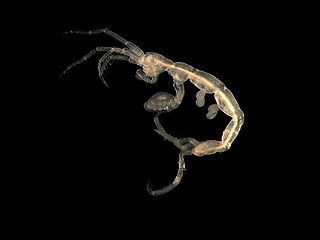
Caprellidae is a family of amphipods commonly known as skeleton shrimps. Their common name denotes the threadlike slender body which allows them to virtually disappear among the fine filaments of seaweed, hydroids and bryozoans. They are sometimes also known as ghost shrimps.

Paratrechina is one of seven ant genera in the Prenolepis genus-group from the subfamily Formicinae. Six species are included in Paratrechina; one of which, the longhorn crazy ant, is a widespread, pantropical pest.

Nebalia is a large genus of small crustaceans containing more than half of the species in the order Leptostraca, and was first described by William Elford Leach in 1814. The genus contains over thirty species:

Manglares de Tumbes National Sanctuary is a protected natural area located in the region of Tumbes, Peru. Established in 1988, it protects the largest area of mangrove forest in Peru.
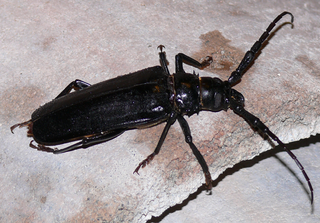
Derobrachus is a genus of beetles in the Cerambycidae. It contains the following species:

Eurydice is a genus of isopod crustaceans named after the mythical Eurydice, wife of the musician Orpheus. It includes the following species:

Haemaphysalis longicornis, the Asian longhorned tick, longhorned tick, bush tick, Asian tick, or cattle tick, is a parasitic arachnid belonging to the tick family Ixodidae. The Asian longhorned tick is a known livestock pest, especially in New Zealand, and can transmit a disease called theileriosis to cattle but not to humans. However, the tick has been associated with several other tickborne diseases in humans.
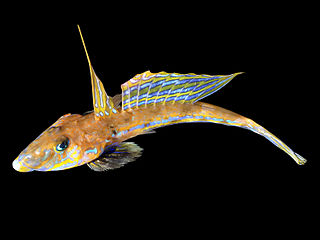
The common dragonet is a species of dragonet which is widely distributed in the eastern North Atlantic where it is common near Europe from Norway and Iceland southwards. It is a demersal species that occurs over sand bottoms. It lives to a maximum age of around seven years. It is caught in bycatch by fisheries and is used in the aquarium trade.
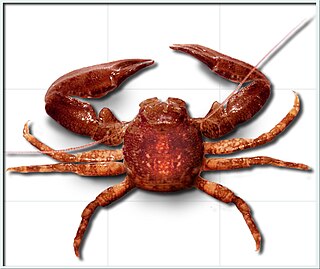
Pisidia longicornis, the long-clawed porcelain crab, is a species of porcelain crab that lives in the north-eastern Atlantic Ocean. It varies from reddish to white, and grows to a carapace width of 1 cm (0.4 in). It was first named by Carl Linnaeus in 1767, although the etymology remains unclear.
In the 10th edition of Systema Naturae, Carl Linnaeus classified the arthropods, including insects, arachnids and crustaceans, among his class "Insecta". Insects with net-veined wings were brought together under the name Neuroptera.

Pogonognathellus longicornis is a common species of springtail present in Europe.
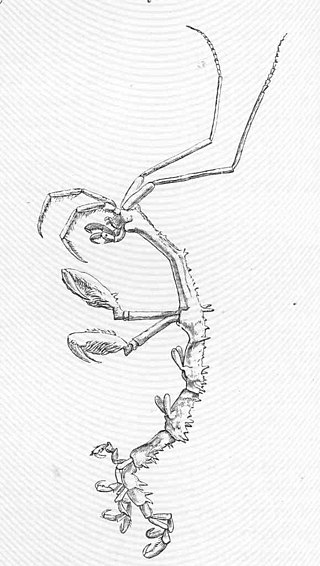
Aeginina is a genus of amphipods in the family Caprellidae. There are at least 2 described species in Aeginina.
Thoron is a genus of scelionid wasps in the family Scelionidae. There are about 10 described species in Thoron.
Hexatoma longicornis is a species of limoniid crane fly in the family Limoniidae.
Cortodera longicornis is a species of flower longhorn in the beetle family Cerambycidae. It is found in North America.

Coelotanypus scapularis is a species of midge in the family Chironomidae. Larvae are aquatic, feeding on diatoms, crustaceans, oligochaetes, and other insects.
Patrobus longicornis is a species of ground beetle in the family Carabidae. It is found in North America.
Pseudozonitis longicornis is a species of blister beetle in the family Meloidae. It is found in North America.













